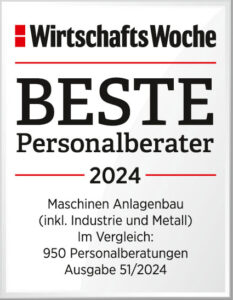Bereits in einigen vorherigen Beiträgen wurde das Thema Best-Practice Profil (BPP) intensiv behandelt. Ein BPP dient dem Vergleich. So lassen sich Schlüsse zur Positionierung des Kandidaten in den einzelnen Persönlichkeitsmerkmalen ziehen und mögliche Entwicklungsfelder und Potenziale aufdecken. Es zeigt, wie die Besten einer Branche „gestrickt“ sind und welche Merkmale besonders für den Erfolg in einem Berufsbild notwendig und förderlich sind. Kurz gesagt ist ein Best-Practice Profil ein Vergleich mit den Besten.
- In diesen Artikel wird darauf eingegangen, welche Vorgehensweise notwendig ist, um ein Best-Practice Profil zu erstellen.Die Erstellung eines Best-Practice Profils besteht aus fünf Schritten: Die erfolgreichsten Mitarbeiter einer Berufsgruppe im Unternehmen müssen als erstes identifiziert werden. Um diese Mitarbeiter erfassen zu können müssen Erfolgskriterien definiert werden. Nach welchen Kriterien sollen die erfolgreichsten Mitarbeiter ausgesucht werden? Welche Zahlen sind ausschlaggebend für den Erfolg? Beispiele für Erfolgskriterien sind der erzielte Umsatz oder die erreichte Rendite. Anschließend wird eine Best-Practice Gruppe aus den erfolgreichsten Mitarbeitern des Unternehmens gebildet sowie die erfolgsrelevanten und überprüfbaren Merkmale gesammelt. In Abbildung 1.1 ist eine Tabelle abgebildet, um die erfolgreichsten Mitarbeiter zu bestimmen.

- Als nächstes führt jeder ausgewählte Mitarbeiter online ein eignungsdiagnostisches Verfahren durch. Dabei handelt es sich um eine Selbsteinschätzung. Es werden die Stärken und Schwächen des Teilnehmers herausgefunden und aufgezeigt. Einige Beispielfragen sind in Abbildung 1.2. zu sehen.

- Es folgt die Auswertung der Eignungsdiagnostik. Das Ergebnis der Eignungsdiagnostik zeigt die verschiedenen Ausprägungen der einzelnen Merkmale bei den erfolgreichsten Mitarbeitern. Indem alle Profile der Best-Practice Gruppe zusammengelegt und ausgewertet werden, entsteht ein Best-Practice Profil. Dieses Profil ist auch als Idealprofil bekannt. Es zeigt, welche Kriterien für die teilnehmenden Mitarbeiter übereinstimmend wichtig bzw. unwichtig sind.
- Aber auch die Auswertungen jedes einzelnen Mitarbeiters werden betrachtet und in einem Individualprofil festgehalten.
- Im letzten Schritt werden die Werte des Individualprofils mit den Werten des Best-Practice Profils verglichen. Es wird eine Abweichungsanalyse durchgeführt. Dabei wird kontrolliert wie weit die Werte von beiden Profilen bei den einzelnen Merkmalen übereinstimmen. Ebenfalls werden die Schlüsselkriterien überprüft. Es wird darauf geachtet, ob es sich um die gleichen Schlüsselkriterien handelt und wie hoch die Differenz zwischen Individual- und Idealprofil ist. In Abbildung 1.3. ist eine Teilauswertung einer Eignungsdiagnostik beispielhaft zu sehen.

Indem das Best-Practice Profil gegen mehrere Vergleichsprofile gespiegelt wird lassen sich bedeutsame Veränderungen der Selbsteinschätzung zu den Werten der Vergleichsgruppe leichter darstellen.
In einem strukturierten Interview lassen sich auf Basis des BPP Abweichungen diskutieren. Zusätzlich kann durch zielgenaues Hinterfragen die Ursachen für die erkennbaren Differenzen geklärt werden.
Im nächsten Beitrag dieser Themenreihe geht es um die Güterkriterien. Welche Kriterien muss ein gutes und seriöses Verfahren erfüllen? Worauf sollte sonst noch geachtet werden?
About the author

After studying automotive engineering and industrial engineering, he began his professional career in the automotive industry in the areas of sales, development and marketing and also spent a year in Japan with one of the largest automotive suppliers.
He then moved to a globally renowned premium car manufacturer, where he was responsible for product marketing in Japan and South America and for marketing strategy in North and South America.
In 1994, he decided to become self-employed and founded a personnel consultancy in Munich, where he has been driving development and expansion for over 20 years. As Managing Director, his industry focus is naturally on the automotive world as well as mechanical and plant engineering.
His doctorate in the field of aptitude diagnostics ideally rounds off his areas of expertise, particularly with regard to personnel and management consulting. The dissertation deals with the identification and verification of typical personality traits of engineers as well as the definition of development areas for a successful professional career.
These are scientifically derived and presented in the book "Eignungsdiagnostik im Praxiseinsatz".
At the same time, his focus is on the development of networks and cooperation models as well as the continuous further development of systems and processes in personnel consulting.
Over the last 20 years in personnel consulting, he has developed several brands that are still operating successfully on the market today.




